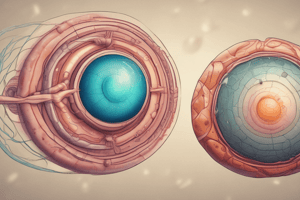Podcast
Questions and Answers
What are alveoli?
What are alveoli?
Milk-secreting cells in the mammary gland.
What is the function of ampulla of the uterine tube?
What is the function of ampulla of the uterine tube?
It is the middle portion of the uterine tube where fertilization often occurs.
What is the areola?
What is the areola?
Highly pigmented, circular area surrounding the raised nipple.
What do Bartholin’s glands do?
What do Bartholin’s glands do?
What does the corpus luteum secrete?
What does the corpus luteum secrete?
What is the function of the cervix?
What is the function of the cervix?
What are gonads?
What are gonads?
What hormone is produced by the pituitary gland to stimulate follicle growth?
What hormone is produced by the pituitary gland to stimulate follicle growth?
What are granulosa cells?
What are granulosa cells?
What is the function of the infundibulum of the uterine tube?
What is the function of the infundibulum of the uterine tube?
What is the role of the lactiferous ducts?
What is the role of the lactiferous ducts?
Study Notes
Reproductive Anatomy Glossary
- Alveoli (of the breast): Milk-secreting cells in the mammary glands critical for lactation.
- Ampulla (of the uterine tube): The central part of the uterine tube where fertilization commonly occurs.
- Areola: A pigmented area surrounding the nipple, containing glands that help lubricate during breastfeeding.
- Bartholin’s glands: Also known as greater vestibular glands; produce mucus to maintain vulvar moisture.
- Body of uterus: The central section of the uterus, crucial for fetal development.
- Broad ligament: A wide ligament that supports the uterus, connecting it to the pelvic wall.
- Bulbourethral glands (Cowper’s glands): Secrete mucus to clean and lubricate the urethra before and during ejaculation.
- Cervix: The lower end of the uterus that connects to the vagina, playing a role during childbirth.
- Clitoris (glans clitoris): Highly sensitive area of the vulva, essential for sexual arousal and pleasure.
- Corpus albicans: A nonfunctional structure in the ovary formed after the corpus luteum regresses.
- Corpus cavernosum: Two columns of erectile tissue in the penis that engorge with blood to facilitate an erection.
- Corpus luteum: Transformed follicle post-ovulation, secreting progesterone to maintain pregnancy.
- Corpus spongiosum: Erectile tissue surrounding the penile urethra, aiding in erection and urination.
- Ductus deferens (vas deferens): Duct that carries sperm from the epididymis to the ejaculatory duct.
- Ejaculatory duct: Connects the ampulla of the ductus deferens with the duct of the seminal vesicle.
- Endometrium: The inner lining of the uterus that thickens and sheds during the menstrual cycle.
- Estrogen: Key hormone in women, thickening the uterine wall monthly and aiding ovulation.
- Epididymis: Coiled structure for sperm maturation and storage until ejaculation.
- Fimbriae: Fingerlike projections at the end of the uterine tubes, assisting in the capture of the egg.
- Follicle: Ovarian structure containing an oocyte and supporting granulosa cells.
- Follicle-stimulating hormone (FSH): Hormone from the pituitary that promotes follicle growth, used in fertility treatments.
- Folliculogenesis: The process of ovarian follicle development influenced by gonadotropins.
- Fundus (of the uterus): The upper dome-shaped part of the uterus located above the uterine tubes.
- Gamete: A haploid reproductive cell, such as sperm or egg, contributing genetic material for offspring.
- Glans penis: The sensitive bulbous tip of the penis containing numerous nerve endings.
- Gonadotropin-releasing hormone (GnRH): Hormone from the hypothalamus that regulates FSH and LH production.
- Gonads: Reproductive organs (testes and ovaries) that produce gametes and hormones.
- Granulosa cells: Cells in the ovarian follicle that support oocyte development and produce estrogen.
- Hymen: Membrane partially covering the vaginal opening, often associated with virginity.
- Infundibulum (of the uterine tube): The wide distal part of the uterine tube that captures the ovulated egg.
- Inguinal canal: An opening in the abdominal wall connecting the testes to the abdominal cavity.
- Isthmus: The narrow part of the uterine tube connecting to the uterus.
- Labia majora: Hair-covered outer folds of skin protecting the vaginal opening.
- Labia minora: Thin, pigmented inner folds of skin located beneath the labia majora.
- Lactiferous ducts: Ducts that transport milk from the mammary glands to the nipple during breastfeeding.
Studying That Suits You
Use AI to generate personalized quizzes and flashcards to suit your learning preferences.
Related Documents
Description
This quiz covers key terms related to mammalian anatomy, specifically focused on breast and reproductive structures. It includes definitions of critical components such as alveoli, ampulla, and areola. Test your understanding of these important concepts in breast physiology and reproductive biology.




